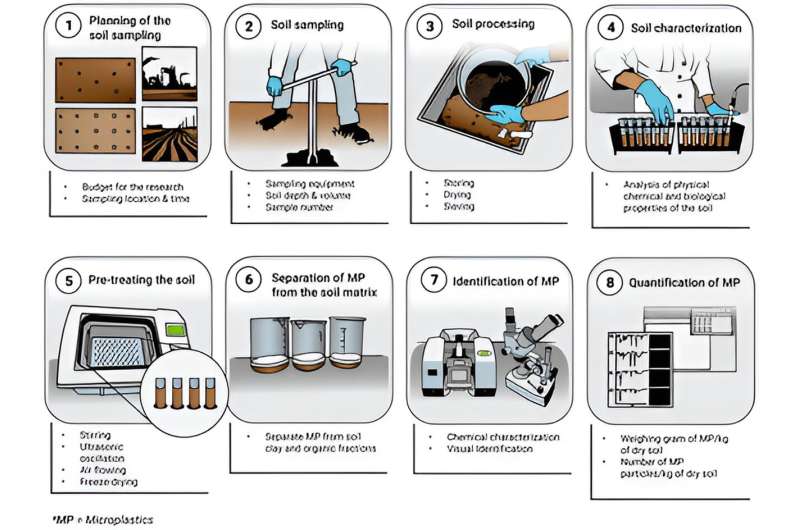This article has been reviewed according to Science X's editorial process and policies. Editors have highlighted the following attributes while ensuring the content's credibility:
fact-checked
proofread
An eight-phase methodology for analyzing microplastics in soil ecosystem

In today's world, plastics are used extensively due to their favorable properties and affordable costs. The widespread use of these non-biodegradable materials, however, makes them a waste management nuisance and global environmental concern. It is estimated that by 2050, approximately 12 billion metric tons of plastic waste will be dumped into landfills.
Plastics entering soils undergo intense weathering and breakdown, resulting in the formation of microplastics (MPs) or plastic fragments less than 5mm in size. These MPs accumulate in soils, alter their chemical and biological characteristics, and exacerbate the menace of plastic pollution. Not only do these MPs pose risks to soil health, but they also affect soil organisms and contaminate plants, endangering the integrity of the entire food chain.
Given the recent attention to microplastic pollution in soils, there is still a lack of a systematic, comprehensive, and standardized procedure for sampling, separating, and analyzing soil MPs. Current analytical methods for soil MPs are usually modified versions of existing marine research, which seldom acknowledge the inherent complexities of soil ecosystems.
To address this research gap, a team led by Prof. Yong Sik Ok from Korea University has now critically evaluated the current analytical approaches for soil MPs and proposed a novel, comprehensive, eight-phase methodology for examining MPs in soils.
Prof. Ok is the Chair and Program Director of the Sustainable Waste Management (APRU SWM) Program for the Association of Pacific Rim Universities (APRU), President of the International ESG (Environmental, Social and Governance) Association (IESGA), and President of the International Society of Trace Element Biogeochemistry (ISTEB), besides being a highly cited researcher since 2018.
Elaborating further on their study, Prof. Ok says, "In a world grappling with the escalating challenges of plastic pollution, our critical evaluation provides crucial insights that can offer significant support for global industries, in line with the United Nations Sustainable Development Goals (SDGs) and ESG principles."
The article was published in Critical Reviews in Environmental Science and Technology.
In this work, Prof. Ok and his team emphasize the importance of soil sampling, homogenization, and aggregate dispersion and examine the physicochemical and biological properties of soils before analyzing the MPs in soils. Based on their analysis, the team suggested a comprehensive methodology with eight phases for analyzing soil MPs.
These phases include 1) careful planning for soil sampling; 2) collecting representative samples; 3) processing the samples, including drying and sieving; 4) characterizing the soil to determine its physicochemical and biological properties; 5) pretreating the soils before separating MPs from it; 6) separating the MPs from the clay and organic components of the soil; 7) identifying the MPs visually or chemically, and finally 8) quantifying the MPs per kilogram of dry soil.
In this methodology, each phase recognizes the significance of considering soil-specific properties, understanding how these can interfere with MP analysis, and overcoming these interferences and other methodological challenges.
This new methodology thus provides a streamlined approach for analyzing soil MPs, ensuring accuracy, precision, reliability, and quality assurance while reducing potential sources of error or contamination.
Moreover, this methodology is easy to reproduce under different settings. Interestingly, the implications of this methodology extend beyond the scientific community. While this systematic approach facilitates data and research comparability and advances scientific understanding, it also promotes international collaboration and knowledge sharing and supports policy development for managing MP pollution.
"Our proposed eight-phase methodology serves as a basis for developing standardized methods for analyzing soil MPs. Such globally accepted standards can be aligned with regulations under the United Nations Environment Programme and can be used for developing international agreements for managing plastic waste."
"Furthermore, our methodology can prove to be a valuable tool and reference for industries, policymakers, and researchers worldwide who are committed to combating plastic pollution and safeguarding the environment," concludes Prof. Ok.
More information: Piumi Amasha Withana et al, Soil microplastic analysis: a harmonized methodology, Critical Reviews in Environmental Science and Technology (2024). DOI: 10.1080/10643389.2023.2301052
Provided by Cactus Communications




















